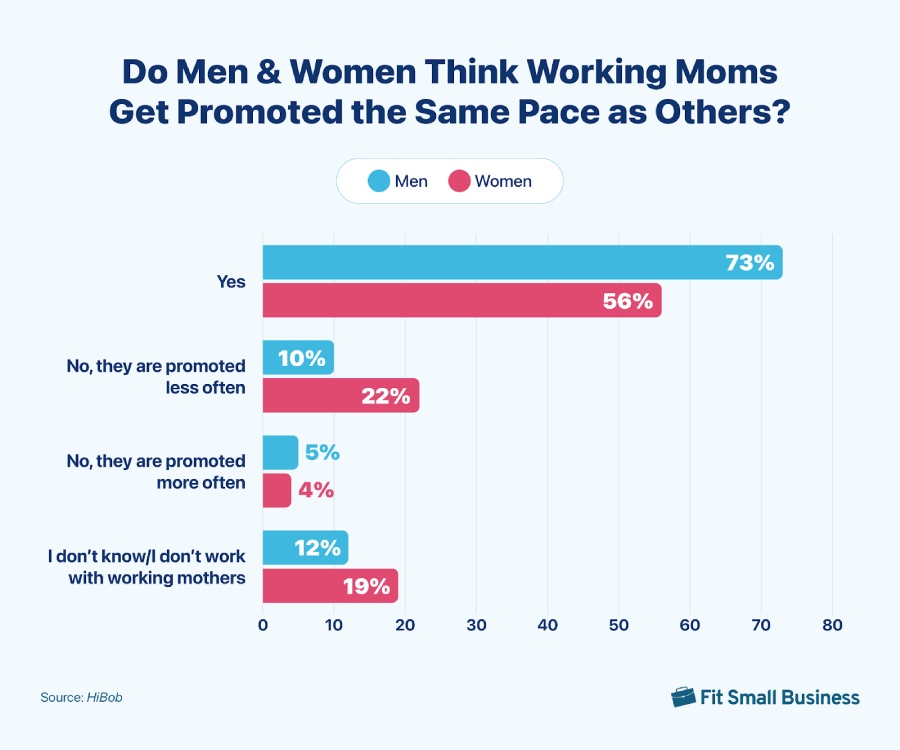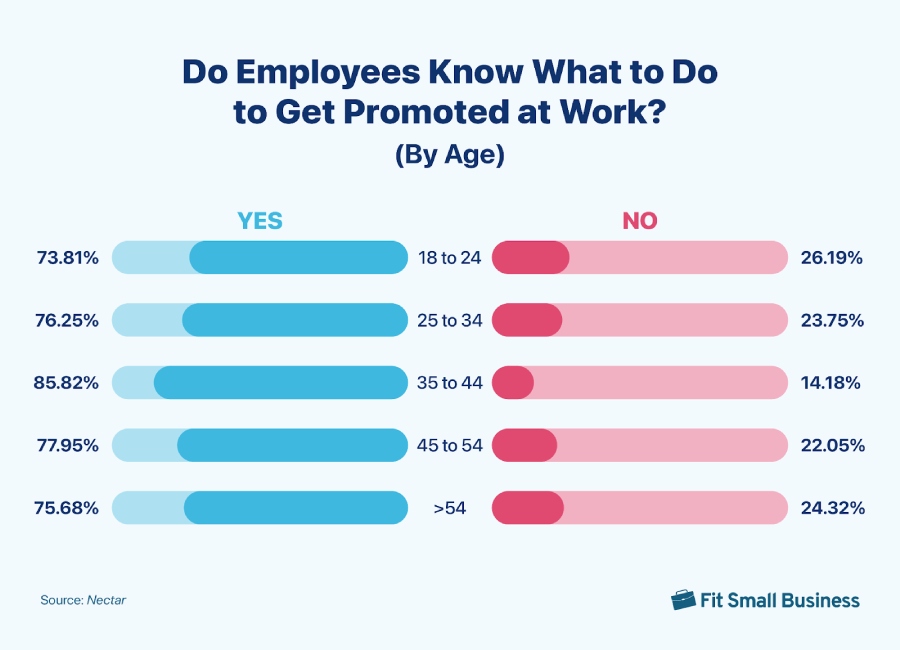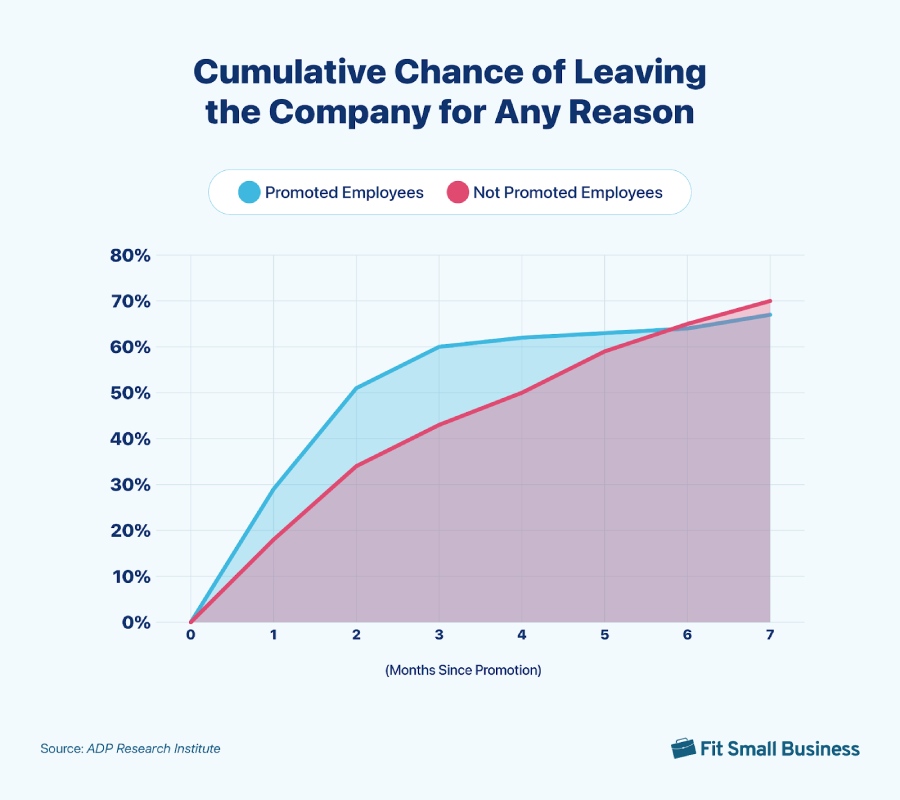Many factors can affect an employer or manager’s decision to promote workers to a higher rank or different position. The process can be complex, and companies have different ways and parameters of choosing who to promote and when to move employees to their new roles.
The employee promotion statistics below provide insight into the latest trends, such as average promotion increases and what other organizations are doing to support career progression plans. This article also contains tips to help ensure you’re promoting workers fairly.
Key Takeaways:
- 31.5% of employees received a promotion in the twelve months before December 2023.
- Men are more often promoted than women.
- In 2024, US companies are only planning to promote 8% of their employees with an average pay adjustment of 9.2% for single-level promotions.
Staff Promotion Demographics
1. More than half (63%) of the US workforce received a promotion in the two years before December 2023
Despite the global economic uncertainty, US companies are still promoting qualified employees. According to a Nectar survey, around two-thirds (or 63%) of their respondents reported getting promoted at work. Half of them (31.5%) were promoted in the one to two years before December 2023 and the remaining half within the twelve months of the same period.
However, the employee promotion stats for the remaining third of the workforce paint a different picture. 7.63% of the respondents haven’t been promoted in five or more years before December 2023, while 14.25% never received a promotion at all.
2. Men are promoted more frequently than women
In 2023, more men (38%) received promotions with pay increases compared to women (32%). While there’s a difference of six percentage points between these genders, the number of promotions among women is higher than the previous year (32% vs 22%).
To prevent gender-related promotion biases, train your managers on unconscious biases and other diversity, equity, and inclusion (DEI) topics. This will increase their awareness, enabling them to recognize when biases may affect their decisions in the workplace. Creating a career path with clear key performance indicators will also help employees know how to progress in their roles.
3. Nearly one in five women (22%) perceive a bias against working mothers in the promotion process
Employee promotion statistics show that while a little over half (56%) of women employees think that working moms are promoted at the same pace as others on the team, 22% think otherwise. On the other hand, nearly three-quarters of male employees believe that working mothers receive the same treatment.
Having a promotion policy will help address this as it serves as your guide on how to promote employees. You can even use HR systems with performance management tools to evaluate employees and monitor promotion demographics. For options, check out our lists of the best HR software and top HRIS solutions.

4. Workers in jobs requiring more education and training have a better chance of getting promoted
Employees whose work needs a graduate degree or extensive training have a 16.2% chance of promotion within their first two years on the job. This is 19 times better than the chance of career advancement for workers whose jobs require a high school diploma and minimal training.
(ADP Research Institute – Today at Work, May 2023)
5. Many Gen Z workers value learning opportunities to help move their careers forward
53% of Gen Z workers (those born after 1996) agree that joining learning programs allows them to explore potential career paths within their organizations. However, only 37% of millennials, Gen X, and baby boomer workers (or those born before 1996) share the same sentiment.
If you want to retain your current Gen Z employees, consider creating a work culture of learning, staff promotion, and employee recognition. These are good motivation and worker retention strategies. You can even highlight it in your careers webpage or mention it in your job postings to attract the incoming Gen Z workforce.
Employee Promotion Sentiment Statistics
6. Almost 8 out of 10 employees know what they need to do to get a promotion
Employee promotion statistics show that 79.5% of full-time US workers are clear about how to get promoted to a different role or higher rank at work. Male workers (83.11%) are also more confident about the mechanics of work promotions compared to female employees (76.25%). In terms of age, 85.82% of those in the 35 to 44-year-old age range understand promotions better than 18 to 24-year-old workers (73.81%).

7. A majority (78%) of workers believe they have the skills to advance their careers to the next level within the next three years
Almost 8 in 10 workers are confident in their skills to progress in their chosen career path. 68% of these workers even said their employers invest in the skills they need to move forward.
(ADP Research Institute – People at Work, 2023)
8. A notable 38% of workers think that building management skills is important to move to the next level at work
Employee promotion stats show that 38% of employees consider management skills the top skill to develop to help them prepare for their future roles in the next five years. This is followed by people skills (33%) and data analysis skills (31%).
(ADP Research Institute – People at Work, 2023)
Key Promotion Statistics for Managers
9. More than one-third (37%) of organizations plan to invest more in training and development to upskill employees and support career progression
With more US workers reaching the retirement age of 65 in 2024, organizations see the value of training existing workers to replace retiring employees. Compared to hiring new staff to replace retiring employees in critical roles, upskilling qualified staff and promoting them to soon-to-be-vacated roles is more cost-effective.
Tip: To help your employees develop the skills they need to move to the next role, work with them in creating professional development goals with short- and long-term objectives. These goals can include completing a project, attending a certification course, or joining a mentorship program if your company offers this.
10. One-third (33%) of companies have internal mobility programs to help employees move into different internal roles
Most learning and development (L&D) leaders see the importance of internal mobility in encouraging workers to explore other roles in the organization. Not only does this help boost employee retention rates, but it also creates a pool of agile workers with cross-functional knowledge and skills.
11. A substantial 86% of HR leaders believe that their organizations’ career paths are unclear for employees
Some organizations may have established internal mobility programs, but HR leaders think it isn’t enough. Traditional career maps that identify the required steps to move up the ladder until a leadership role is assumed are no longer sufficient to cover the evolving needs of businesses and employees.
Consider using adaptive career maps that align with business objectives and the employees’ skills. Aside from improving work adaptability, your workers are not limited to following just one career path—the target can move depending on changes to the organization and the employees’ work interests.
12. Just over half (52%) of US workers feel satisfied with the career progression opportunities at work
A little over half of the US workforce feel optimistic about their future in their current organizations. Many are happy with how their employers manage career progression talks, including the skills and development opportunities they provide to help workers reach their career goals.
(ADP Research Institute – People at Work, 2023)
13. Employers plan to promote fewer employees in 2024
While some companies are keen to create career progression programs to move employees to higher roles, US organizations that joined Mercer’s Compensation Planning survey said they only plan to promote 8% of their workforce in 2024. This is 2.3 percentage points lower than last year, wherein US employers planned to promote 9.3% of their employees.
For this and the below statistics, there are several reasons for the dip in promotions and promotion-related increases—this also varies per industry. Survey respondents in the retail and healthcare industries reported that their struggles with hiring and retention have pushed them to use what they save from promotions to increase their capability to attract and retain qualified workers.
Facing the same challenges but still want to do employee promotions? Be more selective in who you promote—only advance key performers you want to develop and reward with a new role. You can also use a performance management system with a nine-box matrix to help you identify workers who are inconsistent performers and key contributors. If you need product recommendations, check out our guide to the best performance management software.
(Mercer – US Compensation Planning Survey, Q1 2024)
14. Base pay increases for one-level promotions are slightly lower than the previous year
The average pay increase for one-level promotions was 9.4% in 2023. For this year, employers are planning to give, on average, a 9.2% promotion increase for employees who will move one level up.
(Mercer – US Compensation Planning Survey: Q1, 2024)
Unsure whether your promotion increase for a specific position is too low or high? Research what other companies are paying for similar roles. This can give you an idea of the prevailing salary rates.
Note that this is just one of the factors you should consider when planning and calculating employee promotions․ You should also look at the worker′s performanceˌ current salaryˌ your promotion budget and internal equity․
Check out our list of the best salary comparison tools to find a solution that fits your requirements. |
15. Only a handful of US companies have standalone promotion budgets
Most employers include promotion increases when creating a payroll budget for employee salaries and wages, but having a separate budget will help you easily track promotion-related expenses. However, according to Mercer, just under one in four companies have set aside a budget to fund employee promotions and allocated an average of 1.1% for salary increases due to promotions.
(Mercer – US Compensation Planning Survey, 2023)
Promotion-related Resignation Statistics
16. Half of workers (50%) said they would look for a new job if they did not receive their expected promotion in 2024
Not promoting employees can push them to explore opportunities outside of your company. The same goes for workers who don’t have any chance to develop professionally. Instead of tapping external talents to fill vacant roles, why not look at your workforce first? Open the opportunity to your existing employees and move or promote qualified workers who fit the job’s requirements.
17. Employee promotions can increase the risk of workers leaving the company
29% of employees left their employers within a month after their first promotion, according to an ADP study. If these employees were not promoted, only 18% of them would have moved to another organization. The risk is also more pronounced during the first six months of an employee’s promotion, with the number of leavers rising from 29% to over 60%.

This data doesn’t mean that you should avoid promoting employees. As their skills increase, it’s only natural for top talents to become more marketable (and desirable to other companies) given their work experience and leadership capabilities.
As an employer, what you can do is account for this risk when promoting qualified employees if they deserve it and as your organization needs it. Creating a clear career path, providing learning opportunities, and rewarding qualified workers will also help retain employees.
On the other hand, promoted employees may have resigned because they lack the support to become efficient in their new roles. To help prevent this, build an onboarding program with the required training and schedules for 30-, 60- and 90-day manager check-ins to see how they’re adjusting to the new position and further clarify work goals if needed. It should also include meetings with the team members they have to manage and key business partners or colleagues they often need to work with, which are good opportunities to set expectations and understand challenges.
(ADP Research Institute – Today at Work, Sept 2023)
How to Keep Promotion Processes Fair
Employee promotions play an important role in retaining and rewarding employees. To help ensure that your company’s promotion process is fair and transparent, here are some tips.
1. Create a Comprehensive Yet Clear Promotion Policy
Having a clear policy removes the ambiguity in promoting employees. Aside from describing what a promotion means in your organization, it should contain the following:
- Different promotion tiers (e.g., specialist, supervisor, junior manager, senior manager, or director level)
- Promotion criteria, such as the requirements needed (e.g., skills, certifications, work experience, and performance metrics)
- Promotion process, including the required documents to submit, interview process, deadlines, and who to speak to if an employee would like to be considered for a promotion or have questions about the entire process
- A list of persons involved (such as HR leads, managers, and other decision-makers) and their specific roles in the promotion process
2. Build Clear Career Paths and Provide Development Opportunities
By establishing career paths with the key performance indicators (KPIs), you can provide employees with a career progression roadmap and the requirements needed to be successful in their chosen roles or paths. You can even use it to create a development plan and identify the types of training that workers need to enhance their skills.
For individual contributors moving to people manager roles, provide leadership training to help qualified employees develop essential skills in problem-solving, critical thinking, decision-making, and employee management. You can even offer employee coaching opportunities by assigning mentors to top talents.
3. Be Transparent About Internal Work Opportunities
There may be times when there isn’t any promotion opportunity that employees may explore or they lack the skills to assume the next role. Be upfront with your staff if this happens, provide honest feedback, and offer additional training or mentorship to help them build the competencies needed to move to a higher level.
On the other hand, if there are internal vacancies, let your employees know by posting the list on your company message board or through a company-wide newsletter or announcement. Internal recruitment or tapping your internal pool of potential candidates is cheaper than external recruitment. Plus, it requires less onboarding time.
Bottom Line
Employee promotions are a great way of rewarding top talents and boosting staff retention. If done fairly, it can help create a positive company culture that recognizes qualified workers and encourages career advancement within the organization. By looking at employee promotion statistics, you can stay on top of emerging trends to better understand how career advancements and related pay increases work in today’s workplace.


